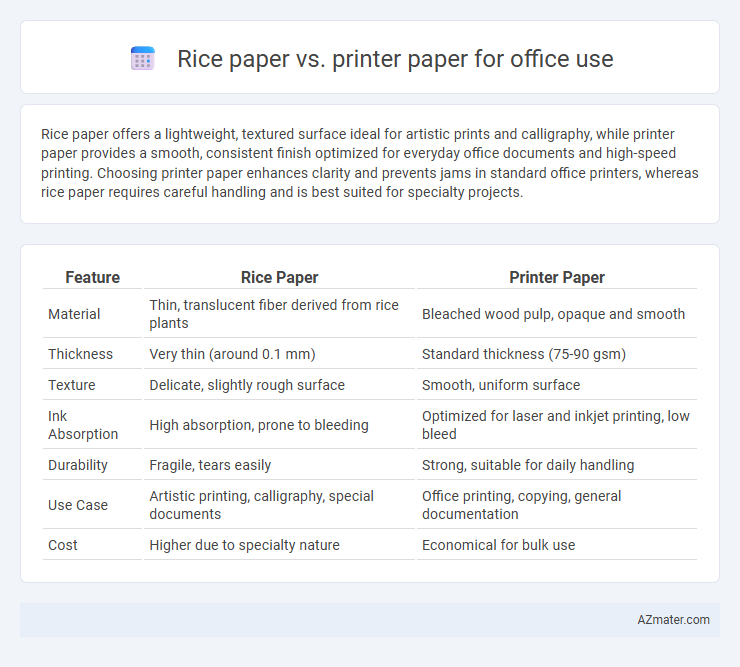Rice paper offers a lightweight, textured surface ideal for artistic prints and calligraphy, while printer paper provides a smooth, consistent finish optimized for everyday office documents and high-speed printing. Choosing printer paper enhances clarity and prevents jams in standard office printers, whereas rice paper requires careful handling and is best suited for specialty projects.
Table of Comparison
| Feature | Rice Paper | Printer Paper |
|---|---|---|
| Material | Thin, translucent fiber derived from rice plants | Bleached wood pulp, opaque and smooth |
| Thickness | Very thin (around 0.1 mm) | Standard thickness (75-90 gsm) |
| Texture | Delicate, slightly rough surface | Smooth, uniform surface |
| Ink Absorption | High absorption, prone to bleeding | Optimized for laser and inkjet printing, low bleed |
| Durability | Fragile, tears easily | Strong, suitable for daily handling |
| Use Case | Artistic printing, calligraphy, special documents | Office printing, copying, general documentation |
| Cost | Higher due to specialty nature | Economical for bulk use |
Introduction: Understanding Office Paper Options
Rice paper offers a textured surface ideal for artistic and specialty printing, while printer paper is designed for high-speed, everyday office printing with smooth, consistent quality. Printer paper typically has a weight of 20-24 lb and a brightness rating around 92-98, ensuring crisp text and sharp images for documents and reports. Choosing the right paper impacts print quality, durability, and compatibility with office printers, making it essential to understand these differences for efficient office use.
What Is Rice Paper?
Rice paper is a lightweight, translucent material traditionally made from the pith of the rice plant or other fibrous plants like mulberry, used primarily for calligraphy, painting, and artistic purposes. Compared to printer paper, rice paper is more fragile and less suitable for standard office printing because it absorbs ink differently and may cause smudging or jamming in printers. Its unique texture and thinness make rice paper ideal for specialty projects rather than everyday office document needs.
What Is Printer Paper?
Printer paper is a high-quality, smooth paper designed specifically for inkjet and laser printers, typically made from wood pulp with a weight of 20 lbs (75 gsm) to 24 lbs (90 gsm). It offers excellent ink absorption, minimal smudging, and consistent feeding through office printers and copiers, ensuring crisp text and vivid images. Unlike rice paper, which is delicate and used primarily for art or specialty writing, printer paper is optimized for durability and everyday office document printing.
Composition and Manufacturing Differences
Rice paper is made from natural fibers like rice straw, hemp, or mulberry bark, resulting in a textured, absorbent surface ideal for calligraphy and art. Printer paper primarily consists of wood pulp treated with bleaching agents and fillers, providing a smooth, uniform surface optimized for ink adhesion and mechanical printing. Manufacturing rice paper involves traditional handcrafting techniques, whereas printer paper is mass-produced using industrial papermaking machines for high consistency and quality control.
Durability and Strength Comparison
Rice paper, known for its delicate texture and thin fibers, lacks the durability and strength required for heavy office use, often tearing easily under stress. Printer paper, typically made from wood pulp with standardized weight and thickness, offers superior tensile strength and resilience, making it ideal for printing, copying, and frequent handling. The higher GSM (grams per square meter) and moisture resistance of printer paper contribute to its enhanced durability compared to the fragile nature of rice paper.
Print Quality: Rice Paper vs Printer Paper
Rice paper offers a unique texture that enhances artistic prints but may result in less sharp text and vibrant colors compared to standard printer paper, which is specifically designed for crisp, high-resolution document printing. Printer paper's smooth surface and optimal weight ensure consistent ink absorption, reducing smudging and improving overall print clarity. For office use requiring professional text and image quality, printer paper remains the superior choice over rice paper.
Compatibility with Office Printers
Rice paper offers a unique texture and aesthetic but often lacks compatibility with standard office printers due to its thin, delicate nature that can cause jams or ink smudging. Printer paper, specifically designed for office use, provides optimal feeding and ink absorption, ensuring crisp, reliable prints with laser and inkjet printers. Selecting printer paper enhances print quality and printer longevity, reducing costly maintenance compared to using rice paper in typical office equipment.
Cost Analysis for Office Budgets
Rice paper, often used for artistic and specialty printing, generally incurs higher costs than standard printer paper due to its unique texture and production process, making it less economical for everyday office use. Standard printer paper offers a cost-effective solution, with prices typically ranging from $3 to $7 per ream, supporting bulk purchasing and budget-friendly office supply management. Factoring in the volume of printing and durability requirements, printer paper remains the more viable option for maintaining office budgets without compromising print quality.
Environmental Impact and Sustainability
Rice paper, made from natural fibers like bamboo or rice straw, offers a biodegradable and compostable alternative to conventional printer paper, reducing landfill waste significantly. Printer paper typically involves deforestation and higher water and chemical usage during production, contributing to greater environmental degradation and carbon emissions. Choosing rice paper supports sustainable forestry practices and lowers ecological footprints, enhancing office sustainability efforts.
Conclusion: Best Paper Choice for Your Office
Rice paper offers a unique texture and aesthetic ideal for creative projects, but its delicacy and cost limit practicality in everyday office tasks. Printer paper remains the best choice for typical office use, providing durability, affordability, and compatibility with standard inkjet and laser printers. For efficient document handling, cost-effectiveness, and optimal print quality, printer paper is the superior option.

Infographic: Rice paper vs Printer paper for Office use
 azmater.com
azmater.com